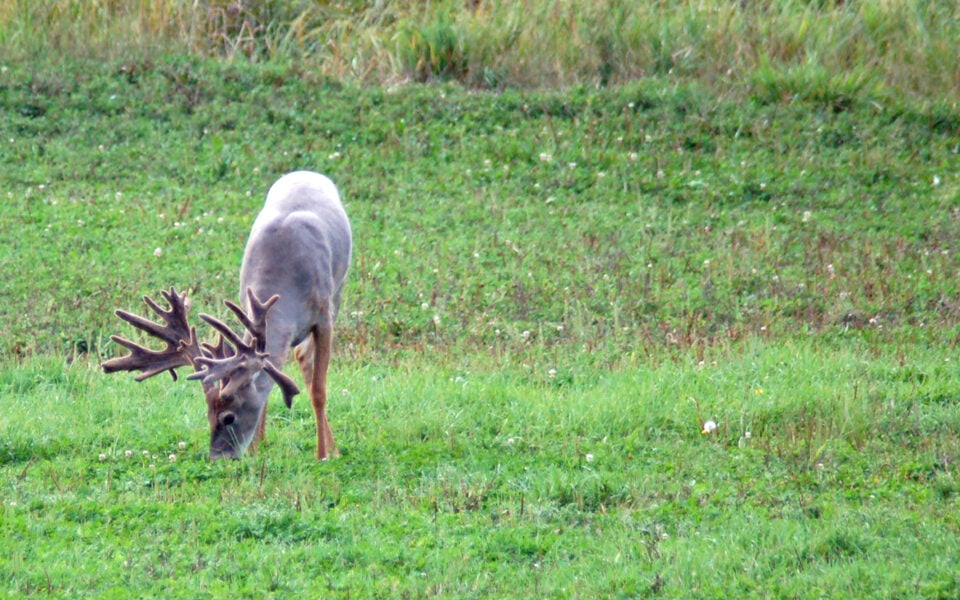Growing Large Whitetails: Many people have the impression that if you want to consistently harvest Boone and Crockett caliber deer, you have to go to Canada or the midwest, but the truth is, it can be done ANYWHERE. The ingredients are simple, but that does not make it any easier to accomplish.
Most biologists agree it takes 3 things to grow Boone and Crockett bucks, most of you know it’s; age, genetics, and nutrition. This is the story of Austin Ashley, a Mississippi gamekeeper and Mossy Oak pro-staff member who was no longer satisfied with the bucks he was shooting, so he set a goal of harvesting a Boone and Crockett buck in south-central Mississippi. In an area that had a grand total of ZERO Boone and Crockett bucks ever harvested, Austin decided to make it happen!
It was an extremely lofty goal, and people said he would fail because the soil in his area was not as rich as the delta. It may have taken many years to accomplish, but Austin improved the basic ingredients of age and nutrition to prove his naysayers wrong in a big way.
Austin Ashley is a hard-working, God-fearing, southern gentleman who graduated high school at the age of 16. His determination to grow Boone and Crockett class bucks began 16 years ago. Austin noticed a particularly nice framed 2.5-year-old 7 pointer living on the family farm. Austin did what he could to the area where that deer was living and “let him walk by” on multiple occasions over the next several years.
As unfortunate luck would have it, a neighbor ended up harvesting the deer in 2008 which scored 171 & 3/8” as a 7.5-year-old. Austin was dejected, but felt accomplished nonetheless. Austin basically grew that deer to what it had become, and if he could repeat those techniques, he knew he could grow another Boone and Crockett caliber buck. Austin has done, and continues to make, extraordinary improvements to his property in order to grow world class deer on what some would call less than optimal soil.
A Gamekeepers progression
First, Austin started with simple food plots. He would buy a bag of “game mix” or “magical ryegrass” from the local hardware store and throw a bag or two of 13-13-13 on the plot to get it going. Now, he has progressed his food plot program to taking soil samples of each plot and using custom fertilizer blends to amend the soil. He has also evolved into using Biologic seed on the property and devotes more acreage to perennial plots like Non-Typical Clover, which he manages yearly.
Additionally, he plants a diverse variety of annual plots. One of his favorite annual blends is the Maximum to which he adds Trophy Oats. He also started planting soybeans and Protein Peas in the summer for the deer. At a broad scale, Austin wanted to ensure deer on his property had plenty of high-quality plants available at different times of the year.
Next, he began using supplemental feed year-round. It all began with a pile of scrap boards his parents had torn down from an old fence from which he made his first feed box. He started with cattle pellets from the local feed store. Now he uses Ani-Logics Outdoors®, a line of high-quality feed and minerals formulated specifically for deer. He wants to make sure the deer using his property always have access to high-quality nutrition even if Mother Nature fails to give his food plots everything they need. If there were drought or floods, Austin knew deer would still have something to eat.
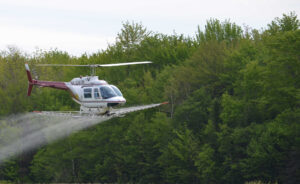
A boost in nutrition is accompanied by an increase in overall body condition, and it’s no secret that healthy deer can devote more energy to antler growth than those that are lacking. In addition to the feed, he established mineral licks next to each food plot. In areas where deer had plenty of protein, they were getting an additional boost of minerals like Calcium, Phosphorus, Magnesium, Copper, Zinc, and Selenium, which are required for premium growth. At every feed station, Austin puts out an Ani-Protein Block 365TM so that if a dominant deer is at the feeder, a subordinate deer can still have something to eat.
Last, but certainly not least, Austin devoted considerable time and energy to improving the habitat. Food plots and feeders provide plenty of nutrition for deer, but where they live most of the time is in and around cover, so improving their habitat, improves their nutrition. He began selectively harvesting timber and cutting clear cuts in a rotational manner to add sunlight to the forest floor which increased the growth of forbs and other browsers.
Austin worked with a forester to use sustainable forest management strategies that wouldn’t affect the quality of timber available for future generations. He planted many soft mass trees such as persimmon and pears to add another food option. He used selective hardwood cuts of sweet gum trees to improve bedding habitat. These cuts also made great food sources where the trees had re-sprouted so the deer was getting an abundance of nutritional value from the stump sprouts.
Age is more than a number
After the habitat/food plot part of the equation was complete, Austin needed to get bucks into older age classes. He started by working with his family to let younger bucks live. In the beginning, it was a struggle to watch a 140-inch deer walk, but eventually, all of that patience began to pay off. Just as when you first begin to let young bucks walk by, to take it to the next level you must let some nice bucks also walk by. When there is a buck that has 140 inches of antler at three years old, that deer has amazing potential when he will be five or six years old. In 2015, both Austin and his dad, Mike, were able to kill Boone and Crockett class bucks. These were bucks they had the opportunity to harvest at younger ages but held off to see what they would become.
Since implementing his year-round nutrition program and getting bucks to older age classes, Austin has realized amazing results. He has harvested 3 bucks that are in the top 10 for archery in the state of Mississippi. His biggest is a 234-inch brute he took this year which will be (after drying and official scoring) the second biggest buck ever harvested with a bow in the Magnolia State.
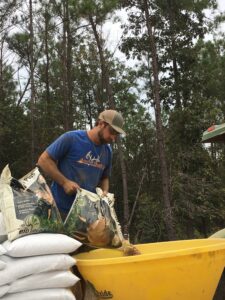
This incredible buck was born to a doe that had great nutrition, and that doe’s mother had great nutrition, so the increase in antler size Austin is seeing now is a cumulative result of several generations of deer living with access to high-quality nutrition. It was 16 years ago that Austin decided to make the switch to only killing mature bucks, and in that time he has not filled his tag on multiple occasions. According to Austin, a lot of people simply can’t wait that long or go a year without shooting a buck. A 150 inch deer is hard for a hunter to pass up when you have limited time to hunt. A deer that size is considered a trophy in a lot of places. The thing that sets Austin apart from most hunters is that he realizes that the same deer could be 200 inches if you give him a year or two more to grow.
If you think you do not have the amount of land that is required to grow big bucks, consider talking to the neighbors. Getting enough support from like-minded hunters can really have a large impact on the size of the deer you are able to harvest. You also have to be aware that not every buck will grow to be Boone and Crockett class no matter how much time and nutrition you give him.
With Austin’s farm, he provides enough food so that he can support more deer per square mile than the poorly managed habitat around his farm. He basically plays a numbers game knowing that it will take a lot of 5 to 7-year-old bucks living on his property to have one that reaches the magical 170-inch mark. Due to this fact, Austin has decided all the bucks that will never reach trophy status are fair game for the many youth hunters and those with disabilities that he invites to his farm each year. He is fully aware that he is not improving genetics by harvesting these bucks, because research has shown, you cannot impact the genetics of a free-range herd just by harvesting certain bucks. To him, shooting mature deer is what it is all about and bucks with Boone & Crockett scoring antlers are simply icing on the cake.
The spotlight shines bright
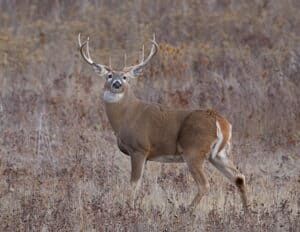 Austin fully understands the problems that can happen if you grow big deer in an area not known for it. Trespassing and neighbors setting up stands on the border of his farm happens more now than it did before he started intensively managing the farm. Austin now checks cameras daily to see if any suspicious activity is occurring.
Austin fully understands the problems that can happen if you grow big deer in an area not known for it. Trespassing and neighbors setting up stands on the border of his farm happens more now than it did before he started intensively managing the farm. Austin now checks cameras daily to see if any suspicious activity is occurring.
In one case, a hunter posted a picture on Facebook of a 140” buck that Austin knew was living on his farm. In the background of the photograph was a very distinct oak tree with a fork in it that Austin recognized. He took the game warden to the exact spot the hunter was posing with the deer, and it was clearly killed on Austin’s property. This led to a poaching conviction of the other hunter. In another instance, Austin was looking at Craigslist just to see what hunting leases were available around him, and one post was titled “Hunting Land-8 miles from Ashley Farms.” You know you are doing something right if people are posting about hunting land that is within 8 miles of yours.
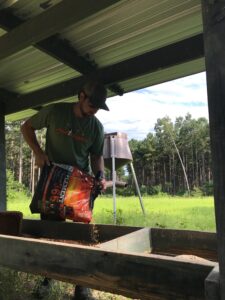
Jealousy runs rampant, and Austin heard rumors that none of the deer he harvested could ever be entered in the local Big Buck Contest because locals believed they came from a high fence. To prove them wrong, Austin won the contest 2 years in a row. He even went so far as passing a polygraph exam when he entered his bucks in the Boone and Crockett record books. People simply had a hard time believing what he had done, but more so where he had done it. Two of his bucks qualified for the all-time record books which requires a net score of 195” for non-typical.
Prior to Austin’s bucks, no other net Boone and Crockett bucks had ever been harvested in his county. Another would have qualified for Boone & Crockett at 205 inches but was in full velvet when it was harvested. Austin declined to strip the velvet just to have it entered in the record book. Austin’s goal wasn’t to put himself on a pedestal for shooting trophy class bucks; it was more to prove to the world that his harvests were legitimate.
Now that he has harvested a handful of these truly world class deer, Austin is concentrating his efforts on becoming a better gamekeeper. His goal is to give more to the land than what he takes out of it. He does things that few other hunters are willing to do: he maximizes age and nutrition of the bucks on his property. In Austin’s words “If you put your time in, manage your property correctly, and pattern bucks over many years, you can grow big bucks ANYWHERE!”

